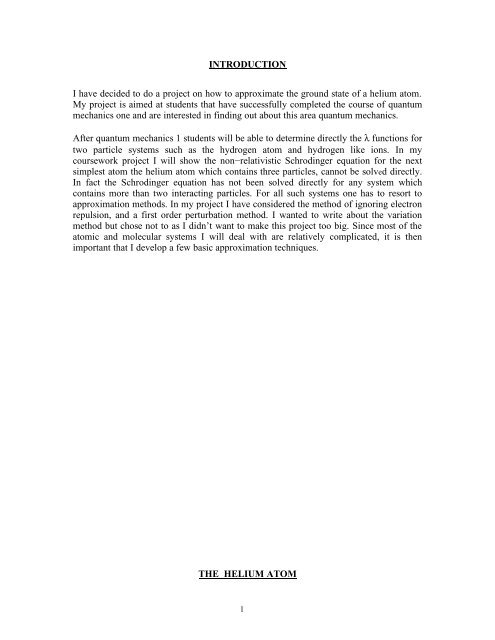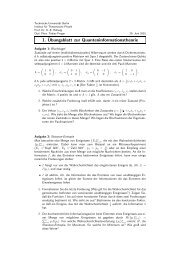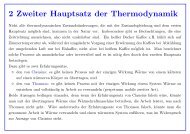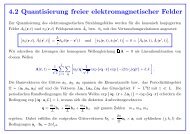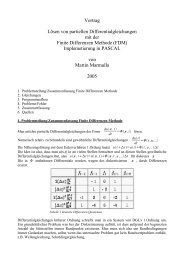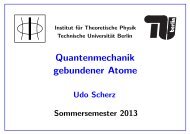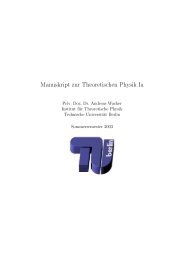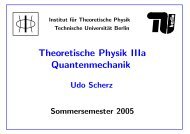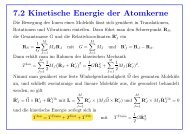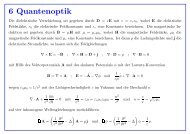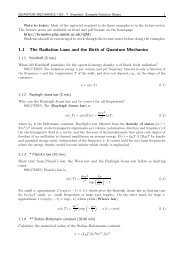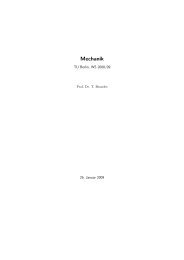INTRODUCTION I have decided to do a project on how to ...
INTRODUCTION I have decided to do a project on how to ...
INTRODUCTION I have decided to do a project on how to ...
- No tags were found...
You also want an ePaper? Increase the reach of your titles
YUMPU automatically turns print PDFs into web optimized ePapers that Google loves.
<str<strong>on</strong>g>INTRODUCTION</str<strong>on</strong>g>I <str<strong>on</strong>g>have</str<strong>on</strong>g> <str<strong>on</strong>g>decided</str<strong>on</strong>g> <str<strong>on</strong>g>to</str<strong>on</strong>g> <str<strong>on</strong>g>do</str<strong>on</strong>g> a <str<strong>on</strong>g>project</str<strong>on</strong>g> <strong>on</strong> <strong>how</strong> <str<strong>on</strong>g>to</str<strong>on</strong>g> approximate the ground state of a helium a<str<strong>on</strong>g>to</str<strong>on</strong>g>m.My <str<strong>on</strong>g>project</str<strong>on</strong>g> is aimed at students that <str<strong>on</strong>g>have</str<strong>on</strong>g> successfully completed the course of quantummechanics <strong>on</strong>e and are interested in finding out about this area quantum mechanics.After quantum mechanics 1 students will be able <str<strong>on</strong>g>to</str<strong>on</strong>g> determine directly the λ functi<strong>on</strong>s fortwo particle systems such as the hydrogen a<str<strong>on</strong>g>to</str<strong>on</strong>g>m and hydrogen like i<strong>on</strong>s. In mycoursework <str<strong>on</strong>g>project</str<strong>on</strong>g> I will s<strong>how</strong> the n<strong>on</strong>−relativistic Schrodinger equati<strong>on</strong> for the nextsimplest a<str<strong>on</strong>g>to</str<strong>on</strong>g>m the helium a<str<strong>on</strong>g>to</str<strong>on</strong>g>m which c<strong>on</strong>tains three particles, cannot be solved directly.In fact the Schrodinger equati<strong>on</strong> has not been solved directly for any system whichc<strong>on</strong>tains more than two interacting particles. For all such systems <strong>on</strong>e has <str<strong>on</strong>g>to</str<strong>on</strong>g> resort <str<strong>on</strong>g>to</str<strong>on</strong>g>approximati<strong>on</strong> methods. In my <str<strong>on</strong>g>project</str<strong>on</strong>g> I <str<strong>on</strong>g>have</str<strong>on</strong>g> c<strong>on</strong>sidered the method of ignoring electr<strong>on</strong>repulsi<strong>on</strong>, and a first order perturbati<strong>on</strong> method. I wanted <str<strong>on</strong>g>to</str<strong>on</strong>g> write about the variati<strong>on</strong>method but chose not <str<strong>on</strong>g>to</str<strong>on</strong>g> as I didn’t want <str<strong>on</strong>g>to</str<strong>on</strong>g> make this <str<strong>on</strong>g>project</str<strong>on</strong>g> <str<strong>on</strong>g>to</str<strong>on</strong>g>o big. Since most of thea<str<strong>on</strong>g>to</str<strong>on</strong>g>mic and molecular systems I will deal with are relatively complicated, it is thenimportant that I develop a few basic approximati<strong>on</strong> techniques.THE HELIUM ATOM1
The helium a<str<strong>on</strong>g>to</str<strong>on</strong>g>m, as depicted in below is a three−particle system which c<strong>on</strong>sist of twoelectr<strong>on</strong>s and a nucleus whose mass is 4.0026 amu (6.6461*10 −24 g) and whose charge is+2e. I will assume that here, just as in the treatment of the hydrogen a<str<strong>on</strong>g>to</str<strong>on</strong>g>m, the <str<strong>on</strong>g>to</str<strong>on</strong>g>talSchrodinger equati<strong>on</strong> may be separated in<str<strong>on</strong>g>to</str<strong>on</strong>g> two equati<strong>on</strong>s, <strong>on</strong>e involving thetranslati<strong>on</strong>al energy of the a<str<strong>on</strong>g>to</str<strong>on</strong>g>m and the other involving the relative moti<strong>on</strong> of theelectr<strong>on</strong>s and the nucleus. I will ignore the translati<strong>on</strong> energy associated with the moti<strong>on</strong>of the centre of mass of the a<str<strong>on</strong>g>to</str<strong>on</strong>g>m in space and will c<strong>on</strong>centrate my attenti<strong>on</strong> <strong>on</strong> therelative moti<strong>on</strong> of particles within the a<str<strong>on</strong>g>to</str<strong>on</strong>g>m and <strong>on</strong> the energy of the relative moti<strong>on</strong>.Furthermore, in my treatment of relative moti<strong>on</strong>, I will assume that the nucleus isstati<strong>on</strong>ary. Although this is no exactly true, the mass of the nucleus is so much larger(about four thousand times larger) than the combined mass of the electr<strong>on</strong>s that theresultant error is not significant.zElectr<strong>on</strong> 2( x2 , y2, z2)1r 2r 12(1 1,1)Electr<strong>on</strong> 1x , y z1r 1ynucleusx1. The potential energy of attracti<strong>on</strong> between the first electr<strong>on</strong> and the nucleus, −2e 2 /r 1 ,where r 1 is the distance between the first electr<strong>on</strong> and the nucleus.2. The potential energy of attracti<strong>on</strong> between the sec<strong>on</strong>d electr<strong>on</strong> and the nucleus,−2e 2 /r 2 , where r 2 is the distance between the sec<strong>on</strong>d electr<strong>on</strong> and the nucleus.3. The potential energy of repulsi<strong>on</strong> between the two electr<strong>on</strong>s +e 2 /r 12 , where r 12 is thedistance between two electr<strong>on</strong>s.2
FIRST APPROXIMATION: IGNORING THE ELECTRON REPULSIONSince the presence of the electr<strong>on</strong> repulsi<strong>on</strong> term in equati<strong>on</strong> (6) prevents me fromobtaining a direct soluti<strong>on</strong>, as a first approximati<strong>on</strong> I will assume that the electr<strong>on</strong>s <str<strong>on</strong>g>do</str<strong>on</strong>g>not repel <strong>on</strong>e another and proceed with the calculati<strong>on</strong>s. By ignoring the <str<strong>on</strong>g>to</str<strong>on</strong>g>tal potentialenergy of the free helium a<str<strong>on</strong>g>to</str<strong>on</strong>g>m is given from equati<strong>on</strong> (1) as2 22e2eV = − −(7)r rand the Schrodinger amplitude equati<strong>on</strong> is2⎡ − h⎢ 2⎣8πme122 22 2 2e2e⎤0 0 0( ∇ + ∇ ) − − ψ = E ψ(8)12r1where the eigenvalues E 0 are the stai<strong>on</strong>ary state energies of reletive moti<strong>on</strong> of the heliuma<str<strong>on</strong>g>to</str<strong>on</strong>g>m assuming no electr<strong>on</strong> repulsi<strong>on</strong> and the eigenfuncti<strong>on</strong> ψ 0 are the wave functi<strong>on</strong>s forthe helium a<str<strong>on</strong>g>to</str<strong>on</strong>g>m in which electr<strong>on</strong> repulsi<strong>on</strong> is ignored. The associated n<strong>on</strong> repulsi<strong>on</strong>0Hamil<str<strong>on</strong>g>to</str<strong>on</strong>g>ni<strong>on</strong> opera<str<strong>on</strong>g>to</str<strong>on</strong>g>r is?H is thenr2⎥⎦2? 0 − hH28 mso that (8) may be written ase2 22 2 2e2e( ∇ +∇ ) − −(9)12r1r2=π)? 00 0 0H ψ = E ψ(10In order <str<strong>on</strong>g>to</str<strong>on</strong>g> separate the variables associated with the first electr<strong>on</strong> from those associatedwith the sec<strong>on</strong>d electr<strong>on</strong>, I will assume that the <str<strong>on</strong>g>to</str<strong>on</strong>g>tal wave functi<strong>on</strong> ψ 0 may be expressedas a product of two functi<strong>on</strong>s, such that the first functi<strong>on</strong> γ 1, depends <strong>on</strong>ly <strong>on</strong> thecoordinates of the first electr<strong>on</strong>, and the sec<strong>on</strong>d functi<strong>on</strong> γ 2, depends <strong>on</strong>ly <strong>on</strong> thecoordinates of the sec<strong>on</strong>d electr<strong>on</strong>. That is( x y , z , x , y , z ) ( x , y , z ) γ ( x , y , z ) (11)0ψ1, 1 1 2 2 2= γ1 1 1 1 2 2 2 2or more simply0ψ = γ1γ2(12)Substituti<strong>on</strong> of equati<strong>on</strong> (12) in<str<strong>on</strong>g>to</str<strong>on</strong>g> equati<strong>on</strong> (8) followed by divisi<strong>on</strong> of both sides byγ 1γ2yields2222⎡ 1 h 2 2e⎤ ⎡ 1 h 2 2e⎤0⎢−∇2 1γ1− ⎥ + ⎢−∇2 2γ2− ⎥ = E⎣ γ18πmer1⎦ ⎣ γ28πmer2⎦(13)4
4E4EE1= and E2=nnH21so that E 0 from equati<strong>on</strong> (16) becomesE⎡ 1 1⎢ +2⎣n1n2= 14EH2H22⎤⎥⎦(22)If each of the electr<strong>on</strong>s in the n<strong>on</strong>repulsive model of the helium a<str<strong>on</strong>g>to</str<strong>on</strong>g>m is in its ground,that is if n 1 =1 and n 2 =1, the ground state energy of the helium assuming no electr<strong>on</strong>repulsi<strong>on</strong> is0E 2E= 8E+ E He= +Hewhere is the ground state energy of a helium i<strong>on</strong>.−11But EHis − 2.18×10 erg, which is equivelent <str<strong>on</strong>g>to</str<strong>on</strong>g> −13.6eV.Thus E 0 , the ground stateenergy for the helium a<str<strong>on</strong>g>to</str<strong>on</strong>g>m in my first approximati<strong>on</strong> is0E = 8( − 13.6eV)(24)EHeThe best experimental value for the energy _of the helium a<str<strong>on</strong>g>to</str<strong>on</strong>g>m in the ground state isgiven in terms of the first i<strong>on</strong>izati<strong>on</strong> potential I, which is the minimum energy absorbedin the reacti<strong>on</strong> in which the first electr<strong>on</strong> leaves the ground state of a helium a<str<strong>on</strong>g>to</str<strong>on</strong>g>m <str<strong>on</strong>g>to</str<strong>on</strong>g>become a free electr<strong>on</strong>:He (ground state) → He + + e(25)Since the minimum kinetic energy corresp<strong>on</strong>ds <str<strong>on</strong>g>to</str<strong>on</strong>g> an ejected electr<strong>on</strong> having notranslati<strong>on</strong>al kinetic energy, I can write the balance for equati<strong>on</strong> (25) asEHe+ I = E +He(26)But I am able <str<strong>on</strong>g>to</str<strong>on</strong>g> solve the Schrodinger amplitude equati<strong>on</strong> forequati<strong>on</strong> 23 that0E = / 2 = −54.4eV+ EHeHE He+(23)directly and s<strong>how</strong> byand I is experimentally determined <str<strong>on</strong>g>to</str<strong>on</strong>g> be 24.6eV. Thus from equati<strong>on</strong> (26), theexperimental value for the ground state energy of a helium a<str<strong>on</strong>g>to</str<strong>on</strong>g>m is given asE = −54.4eV− 24.6eV 79.0eVHe=E 0A comparis<strong>on</strong> ofHe (experimental) from equati<strong>on</strong> (27) with E (calculated) in equati<strong>on</strong>(24) indicates that in the first approximati<strong>on</strong> method, the calculated value for the groundstate energy is of a helium a<str<strong>on</strong>g>to</str<strong>on</strong>g>m is 38% lower (algebraically) than the experimentalvalue. Such a large error indicates that the electr<strong>on</strong> repulsi<strong>on</strong> cannot be ignored.(27)6
SECOND APPROXIMATION:A FIRST ORDER PERTABATION METHODI <str<strong>on</strong>g>have</str<strong>on</strong>g> s<strong>how</strong>n that the correct Schrodinger wave equati<strong>on</strong> for the helium a<str<strong>on</strong>g>to</str<strong>on</strong>g>m isH ? ψ = Eψ ,(2)Where222 2 2? − h 2 − h 2 2e2eeH = ∇1− ∇2− − +(28)228πme8πmer1r2r12Equati<strong>on</strong> (2) cannot be solved directly, which means that we cannot directly evaluate thetrue wave functi<strong>on</strong>, ψ . I <str<strong>on</strong>g>have</str<strong>on</strong>g> s<strong>how</strong>n that if electr<strong>on</strong> repulsi<strong>on</strong> ignore electr<strong>on</strong> repulsi<strong>on</strong>is ignored, then? 0 0 0 0H ψ = E ψ(29)can be directly solved where, from equati<strong>on</strong> (9)222 2? 0 − h 2 h 2 2e2eH = ∇1− ∇2− −(30)228πme8πmer1r20and where the eigenfuncti<strong>on</strong>sψ are the wave functi<strong>on</strong>s for the helium a<str<strong>on</strong>g>to</str<strong>on</strong>g>m in whichelectr<strong>on</strong> repulsi<strong>on</strong> is ignored. Substituting equati<strong>on</strong> (30) in<str<strong>on</strong>g>to</str<strong>on</strong>g> equati<strong>on</strong> (28) yield2? ? 0 eH = H +(31)r12and substituti<strong>on</strong> of equati<strong>on</strong> (31) in<str<strong>on</strong>g>to</str<strong>on</strong>g> equati<strong>on</strong> (2) yields2⎛? 0 e ⎞⎜H + ψ Eψ(32)r⎟ =⎝12 ⎠an equati<strong>on</strong> which cannot be directly solved. I will now compare equati<strong>on</strong>s (29) andequati<strong>on</strong>s (32). The difference in the opera<str<strong>on</strong>g>to</str<strong>on</strong>g>rs in the two eigenvalue equati<strong>on</strong>s is therepulsi<strong>on</strong> terme 2 / r12. The smaller the value of thee 2 / r12the closer the two equati<strong>on</strong>swill be. If I lete 2 / r12equal zero (ignore electr<strong>on</strong> repulsi<strong>on</strong>) then the two equati<strong>on</strong>s willbe the same. This means that E values are given by E o values and ψ functi<strong>on</strong>s are given0byψ functi<strong>on</strong>s.7
When using the perturbati<strong>on</strong> method I will assume thate 2 / r12is small enough <str<strong>on</strong>g>to</str<strong>on</strong>g> bec<strong>on</strong>sidered as a minor modificati<strong>on</strong> or perturbati<strong>on</strong> of the opera<str<strong>on</strong>g>to</str<strong>on</strong>g>r0 ?H , an opera<str<strong>on</strong>g>to</str<strong>on</strong>g>r forwhich we may directly calculate the eigenfuncti<strong>on</strong>s0ψ . I will further hope that theperturbati<strong>on</strong> of the opera<str<strong>on</strong>g>to</str<strong>on</strong>g>r0ψ will not be <str<strong>on</strong>g>to</str<strong>on</strong>g>o different from ψ (which cannot bedirectly evaluated)Thus when evaluating the ground state energy of a helium a<str<strong>on</strong>g>to</str<strong>on</strong>g>m in a given state, I willcombine the use of the correct hamil<str<strong>on</strong>g>to</str<strong>on</strong>g>ni<strong>on</strong> opera<str<strong>on</strong>g>to</str<strong>on</strong>g>r H ? = H ? 0+ e 2 / r12with an incorrect0wave functi<strong>on</strong>ψ for that state which is regarded <str<strong>on</strong>g>to</str<strong>on</strong>g> be fairly close <str<strong>on</strong>g>to</str<strong>on</strong>g> what the correct0wave functi<strong>on</strong> should be. The n<strong>on</strong>repulsive opera<str<strong>on</strong>g>to</str<strong>on</strong>g>r?H is said <str<strong>on</strong>g>to</str<strong>on</strong>g> be perturbed <str<strong>on</strong>g>to</str<strong>on</strong>g> the firs<str<strong>on</strong>g>to</str<strong>on</strong>g>rder by terme 2 / r12, and the present method of approximati<strong>on</strong> is called a first orderperturbati<strong>on</strong> method. The previous approximati<strong>on</strong> method in which I ignored electr<strong>on</strong>0repulsi<strong>on</strong> al<str<strong>on</strong>g>to</str<strong>on</strong>g>gether is called a zero order perturbati<strong>on</strong> method, since I used?H directlyas the opera<str<strong>on</strong>g>to</str<strong>on</strong>g>r. This means that I added no perturbati<strong>on</strong> terms <str<strong>on</strong>g>to</str<strong>on</strong>g> the n<strong>on</strong>repulsive0hamil<str<strong>on</strong>g>to</str<strong>on</strong>g>ni<strong>on</strong> that I used. It is important <str<strong>on</strong>g>to</str<strong>on</strong>g> menti<strong>on</strong> that for a given state,ψ is not aneigenfuncti<strong>on</strong> of H ? and therefore the operati<strong>on</strong> of H ? 0<strong>on</strong>ψ will not yield an exactenergy eigenvalue. Rather, because of the perturbati<strong>on</strong> of energy due <str<strong>on</strong>g>to</str<strong>on</strong>g> the repulsi<strong>on</strong>term, the value of E obtained by the operati<strong>on</strong> H ? 0<strong>on</strong>ψ for a given state will depend <strong>on</strong>the relative positi<strong>on</strong>s of the two electr<strong>on</strong>s so that an approximate average value of E ~must be calculated through use of the mean value postulate as~E =∞∫ψ−∞∞∫− ∞*0ψH?ψ*0ψ00dτdτ=∞∫− ∞ψ*0( H?0 2 0ψ + e ψ / r )∞∫− ∞ψ*0ψ0dτ12dτSubstituting of equati<strong>on</strong> (29) in<str<strong>on</strong>g>to</str<strong>on</strong>g> equati<strong>on</strong> (33) yields~E =∞∫−∞but since for any given state,ψ*00E ψ0dτ+∞∫−∞ψ∞∫−∞*00E is c<strong>on</strong>stantψψ*002( e / r )dτ12ψ0dτ(33)(34)8
ø0*0= ø = ã1ã2⎛ ⎞⎜ ⎟= ⎝ ð ⎠31 ⎛ 2 ⎞− 2r2 / a0−2r2/ a0⎜⎝ a0⎟⎠ee(40)∞∫−∞∞∫−∞ø ø dô = 1øand∞∫−∞ø*1*2ø*01ø21dô02dô= 1∞∞= ∫ ∫− ∞ − ∞ø*1ø1.ø*2ø2dô1dô2= 1(41)Substituting equati<strong>on</strong>s (40) and (41) in<str<strong>on</strong>g>to</str<strong>on</strong>g> equati<strong>on</strong> (37) yields∞ 2⎛ 8 ⎞ eE’ =⎜⎟3 ∫ −2 ⎝ ða0⎠ −∞r2 / a0− 2r2/ a012 e eor, in terms of the co−ordinates of each of the particles,22∞r 2( ) dô∞ 2⎛ 8 ⎞ eE’ =⎜⎟3 ∫ ∫ −⎝ ða0 ⎠ −∞ − ∞r12( ) 2 r 2 22 / a0− r2/ ae e0 dô ô 1d2(43)5 5= − EH =− ( −13.6eV) = + 34.0eV2 2(44)0’Substituting of the value for E form equati<strong>on</strong> (24) and E from equati<strong>on</strong> (44) in<str<strong>on</strong>g>to</str<strong>on</strong>g>equati<strong>on</strong> (36) yieldsE ~ = −108 . 8 + 34.0 = −74.8eV(45)for the approximate ground state energy of the helium a<str<strong>on</strong>g>to</str<strong>on</strong>g>m, as calculated by a firs<str<strong>on</strong>g>to</str<strong>on</strong>g>rder perturbati<strong>on</strong> method. A comparis<strong>on</strong> of E ~ (−74.8eV) with the experimental value(−79.0eV) s<strong>how</strong>s that the calculated value is about 5.3% <str<strong>on</strong>g>to</str<strong>on</strong>g>o high algebraically. If I usethe calculated E ~ value <str<strong>on</strong>g>to</str<strong>on</strong>g> compute a value for the i<strong>on</strong>isati<strong>on</strong> potential, then I getI E ~calc= E + −He= −54.4 − − 74.8 = 20.4( ) eVAs compared with the experimental value of I, which is 24.6eV, the value calculated byperturbati<strong>on</strong> method is 17% <str<strong>on</strong>g>to</str<strong>on</strong>g>o low. It appears that a comparis<strong>on</strong> of calculated andexperimental first i<strong>on</strong>isati<strong>on</strong> potentials is a more sensitive measure of the accuracy of thegiven approximati<strong>on</strong> method than is a comparis<strong>on</strong> of ground state energies, the reas<strong>on</strong>sbeing that the i<strong>on</strong>isati<strong>on</strong> potential is a measure of a difference in energy levels.(42)10


